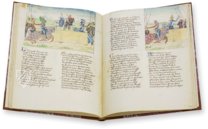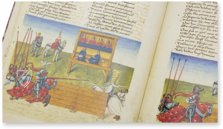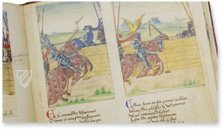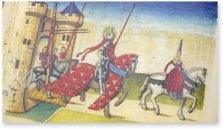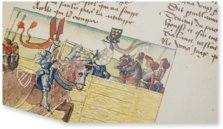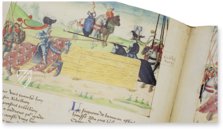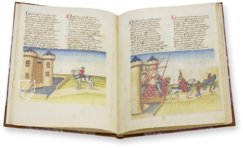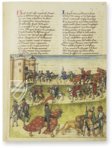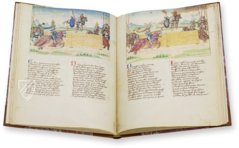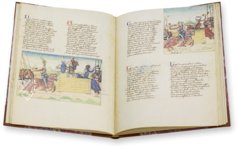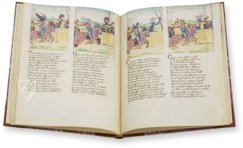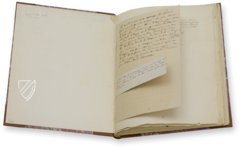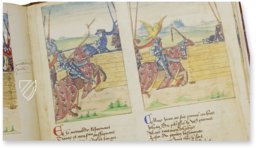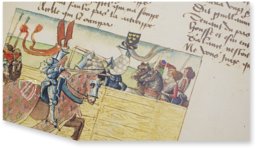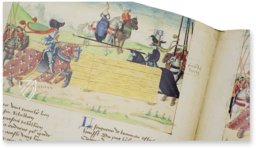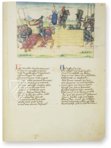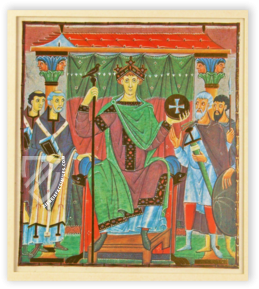Tournament Book of René d´Anjou
(1,000€ - 3,000€)
A knights' tournament was more than a sporting competition. The fighters could show the values of a whole rank: for example, êre (dignity); manheit (bravery) and staete (constancy). They were events of idealizing self-expression and self-affirmation of a core group of society. René d'Anjou (1409–80), King of Naples and Sicily, Duke of Anjou, Bar, and Lorraine, organized tournaments that were sung about by poets throughout the country. This manuscript commissioned by him describes an extraordinary tournament in Saumur on the Loire in 1446 to which he invited the elite of the French upper nobility. The 3,952 verses describe in detail the clothing and weapons of the participants. The decisive moments of the tournament are reproduced for posterity in 90 masterly watercolor pen and ink drawings. They are based on the lost original drawings by Barthélemy d'Eyck (ca. 1420 – ca. 1470).
Tournament Book of René d’Anjou
One of the most precious manuscripts now kept in the Russian National Library in Saint Petersburg is the Tournament Book of René d’Anjou, which is famous throughout the world for its remarkable contents and text. Produced in the 1470's, the manuscript contains the only known version of a poetic description of the Pas de Saumur, a sumptuous tournament that King René had organized for his knights at Saumur in the year 1446. The codex encompasses 91 illustrations of great historic value, which fascinate through their momentum and great feel for vivid detail. These masterfully executed pictures are based on the lost original drawings of Barthélemy d’Eyck, an excellent painter who was active for a long period at René’s court. The great value of the poem as a historic and literary monument of the 15th century and the undisputed rarity of the text have not only drawn the attention of researchers specialized in medieval history, literature and culture. The manuscript also offers a wealth of valuable material for studies in medieval heraldry, as the illustrations show a great number of escutcheons and crests.
The Only Account of the pas d’armes at Saumur
The Saint Petersburg manuscript is the only historic witness to the sumptuous knights’ festival organized in Saumur, which put all other tournaments to shame. It enables us to reconstruct the course of this great event in full detail. This very important aspect makes the manuscript an informative document on the history of the knightly mock battles of the late Middle Ages. The author reports on the organization and the ceremony of the joust (in which only two knights at one time were allowed to charge each other), on actors and combatants; description of the knights' equipment, especially the bascinets, as well as the harnesses and mantling worn by the combat horses. He goes even further and tries to present tournaments, which were obviously among the essential themes of the courtly and knightly culture, in their true significance.
René d’Anjou: a Politician, Patron, and Poet
René d’Anjou, King of Naples and Sicily, Duke of Anjou, Bar, and Lorraine, was one of the most generous tournament hosts of his era. He was not only an ambitious sovereign but also an educated patron of the arts. Beyond that, he also tried his luck as a poet. Numerous works from his pen, among them the Livre du Cuer d’Amours Espris, a romantic allegory, bear testimony to the king’s talent for this genre among others. René also knew how to hold glorious festivals. The tournaments he arranged were famous throughout the country and sung by a great many poets.
A Mirror of the Knightly Way of Life
The organizer of the tournament, René himself, probably commissioned the Saint Petersburg manuscript. He hired a poet, whose name has been lost in the course of history, to write a poetic description of the sumptuous pas d’armes. However, out of all festive events that took place there, the writer chose to describe only the combat scenes, with only a few exceptions. He was obviously less keen on the results of the competition than on an extensive description of the arms depicted on the shields, the horses’ harnesses, and the helmets worn by the participants. This might be due to the king’s wish according to which each participant was to display his own heraldic device, the cuir bouilli, the crest and the coat of arms on his shield, and these instructions conferred the arms and helmets the greatest importance. The 3,952 verses also contain statements concerning the significance of tournaments in the contemporary knightly society as well as indications of the code of behavior and honor to which every participant had to bow. The ritualized combat was a means for the knights to demonstrate their ideals of life: braveness and generosity, honor and glory, fealty and courtly love. In this commission, the author reveals himself as a master of the poetic form used, keeping strictly to the verse structure and rhythm in each stanza. He appears to have been an enormously learned poet, well experienced in the making of a poetic text.
The Miniatures
The narrative of the work is visually supported by numerous illustrations, whereby picture and text are closely related to each other. The illustrations are all drawn with a pen and then painted with watercolors. Differences in color and the reproduction of landscapes as well as different representations of knights and their bascinets make us assume that the manuscript is the work of several hands. The miniatures often constitute a valuable addition to the text and one may say that the illustrated cycle as well as the text both determine the value of the work as a historic source to the same extent.
Codicology
- Alternative Titles
- Turnierbuch für René d´Anjou
- Size / Format
- 108 pages / 37.0 × 27.0 cm
- Origin
- France
- Date
- Around 1446
- Epochs
- Style
- Language
- Patron
- René d’Anjou, king of Naples and Sicily, duke of Anjou, Bar and Lorraine
- Artist / School
- Barthélemy d’Eyck
Tournament Book of René d´Anjou
Two Knights Jousting
As their retainers look on, two knights in full plate armor and separated by a “tilt barrier” charge at one another in the tournament’s most iconic event – the joust. Both knights wear elaborate helmets adorned with colorful bands and birds, which were considered to be the most noble of animals and as such were the most highly prized on aristocratic dinner tables. Their horses wear spike chanfrons to protect their faces and are adorned by caparisons with elaborate designs.
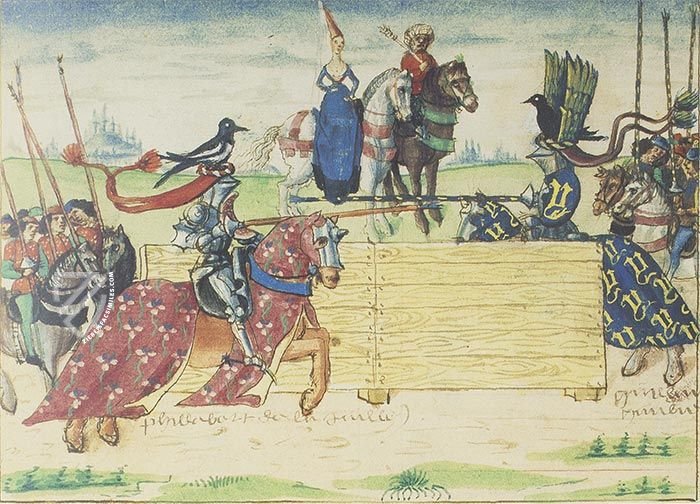
Tournament Book of René d´Anjou
A Splendid Parade
Tournaments originated as little more than brawls between knights who were bored and up to no good. These often-lethal contests could spill into lanes, farmer’s fields, and even peasants’ houses. Tournaments became much more organized and theatrical during the Late Middle Ages – as well as safer – and as such spectacles like a parade increasingly became a part of the festivities.
This procession of noble knights is preceded by two lions, the kings of beasts, which are led along on chains by two handlers. Armored knights and noble ladies ride out from the castle gate and across the drawbridge as they wind their way toward the beholder. Trumpeters with flags hanging from their instruments announce the procession’s approach to the tournament field.

#1 Das Turnierbuch für René d´Anjou
Language: German
The scholarly commentary published to accompany the facsimile edition is divided into two sections, one of which analyses the manuscript from different angles: J. Malinin, a specialist in French medieval history, deals with the author and his work; the contribution by N. Elagina, curator of the Collection of western manuscripts in the Russian National Library, contains a detailed description of its character, the results of the text analysis and an analysis of the illustrations; D. Zypkin presents the outcomes of his codicological examination; and T. Voronova analyses the stocks of King René’s library now kept in the collections of the Russian National Library. The second section of the commentary volume offers the first complete transcription of the original text in Old French.
N. Elagina, J. Malinin, T. Voronova, D. Zypkin, St. Petersburg. Detailed schol-arly commentary on contents, structure, history of origin and the significance of the codex with respect to history of art and history; transcription of the Old French text.
(1,000€ - 3,000€)
- Treatises / Secular Books
- Apocalypses / Beatus
- Astronomy / Astrology
- Bestiaries
- Bibles / Gospels
- Chronicles / History / Law
- Geography / Maps
- Saints' Lives
- Islam / Oriental
- Judaism / Hebrew
- Single Leaf Collections
- Leonardo da Vinci
- Literature / Poetry
- Liturgical Manuscripts
- Medicine / Botany / Alchemy
- Music
- Mythology / Prophecies
- Psalters
- Other Religious Books
- Games / Hunting
- Private Devotion Books
- Other Genres
- Afghanistan
- Armenia
- Austria
- Belgium
- Colombia
- Croatia
- Cyprus
- Czech Republic
- Denmark
- Egypt
- Ethiopia
- France
- Germany
- Greece
- Hungary
- India
- Iran
- Iraq
- Israel
- Italy
- Japan
- Lebanon
- Luxembourg
- Mexico
- Morocco
- Netherlands
- Palestine
- Peru
- Poland
- Portugal
- Russia
- Serbia
- Spain
- Sri Lanka
- Sweden
- Switzerland
- Syria
- Turkey
- Ukraine
- United Kingdom
- United States
- Uzbekistan
- Aboca Museum
- Ajuntament de Valencia
- Akademie Verlag
- Akademische Druck- u. Verlagsanstalt (ADEVA)
- Aldo Ausilio Editore - Bottega d’Erasmo
- Alecto Historical Editions
- Alkuin Verlag
- Almqvist & Wiksell
- Amilcare Pizzi
- Andreas & Andreas Verlagsbuchhandlung
- Archa 90
- Archiv Verlag
- Archivi Edizioni
- Arnold Verlag
- ARS
- Ars Magna
- ArtCodex
- AyN Ediciones
- Azimuth Editions
- Badenia Verlag
- Bärenreiter-Verlag
- Belser Verlag
- Belser Verlag / WK Wertkontor
- Benziger Verlag
- Bernardinum Wydawnictwo
- BiblioGemma
- Biblioteca Apostolica Vaticana (Vaticanstadt, Vaticanstadt)
- Bibliotheca Palatina Faksimile Verlag
- Bibliotheca Rara
- Boydell & Brewer
- Bramante Edizioni
- Bredius Genootschap
- Brepols Publishers
- British Library
- C. Weckesser
- Caixa Catalunya
- Canesi
- CAPSA, Ars Scriptoria
- Caratzas Brothers, Publishers
- Carus Verlag
- Casamassima Libri
- Chavane Verlag
- Christian Brandstätter Verlag
- Circulo Cientifico
- Club Bibliófilo Versol
- Club du Livre
- CM Editores
- Collegium Graphicum
- Collezione Apocrifa Da Vinci
- Comissão Nacional para as Comemorações dos Descobrimentos Portugueses
- Coron Verlag
- Corvina
- CTHS
- D. S. Brewer
- Damon
- De Agostini/UTET
- De Nederlandsche Boekhandel
- De Schutter
- Deuschle & Stemmle
- Deutscher Verlag für Kunstwissenschaft
- DIAMM
- Droz
- E. Schreiber Graphische Kunstanstalten
- Ediciones Boreal
- Ediciones Grial
- Ediclube
- Edições Inapa
- Edilan
- Editalia
- Edition Deuschle
- Edition Georg Popp
- Edition Leipzig
- Edition Libri Illustri
- Editiones Reales Sitios S. L.
- Éditions de l'Oiseau Lyre
- Editions Medicina Rara
- Editorial Casariego
- Editorial Mintzoa
- Editrice Antenore
- Editrice Velar
- Edizioni Edison
- Egeria, S.L.
- Eikon Editores
- Electa
- Emery Walker Limited
- Enciclopèdia Catalana
- Eos-Verlag
- Ephesus Publishing
- Ernst Battenberg
- Eugrammia Press
- Extraordinary Editions
- Fackelverlag
- Facsimila Art & Edition
- Facsimile Editions Ltd.
- Facsimilia Art & Edition Ebert KG
- Faksimile Verlag
- Feuermann Verlag
- Folger Shakespeare Library
- Franco Cosimo Panini Editore
- Friedrich Wittig Verlag
- Fundación Hullera Vasco-Leonesa
- G. Braziller
- Gabriele Mazzotta Editore
- Gebr. Mann Verlag
- Gesellschaft für graphische Industrie
- Getty Research Institute
- Giovanni Domenico de Rossi
- Giunti Editore
- Graffiti
- Grafica European Center of Fine Arts
- Guido Pressler
- Guillermo Blazquez
- Gustav Kiepenheuer
- H. N. Abrams
- Harrassowitz
- Helikon
- Hendrickson Publishers
- Henning Oppermann
- Herder Verlag
- Hes & De Graaf Publishers
- Hoepli
- Holbein-Verlag
- Hortus Deliciarum
- Houghton Library
- Hugo Schmidt Verlag
- Idion Verlag
- Il Bulino, edizioni d'arte
- ILte
- Imago
- Insel Verlag
- Instituto Nacional de Antropología e Historia
- Istituto dell'Enciclopedia Italiana - Treccani
- Istituto Ellenico di Studi Bizantini e Postbizantini
- Istituto Geografico De Agostini
- Istituto Poligrafico e Zecca dello Stato
- Italarte Art Establishments
- J. Thorbecke
- Jan Thorbecke Verlag
- Johnson Reprint Corporation
- Josef Stocker
- Josef Stocker-Schmid
- Jugoslavija
- Karl W. Hiersemann
- Kasper Straube
- Kaydeda Ediciones
- Kindler Verlag / Coron Verlag
- Kodansha International Ltd.
- Konrad Kölbl Verlag
- Kurt Wolff Verlag
- La Liberia dello Stato
- La Linea Editrice
- La Meta Editore
- Lambert Schneider
- Landeskreditbank Baden-Württemberg
- Leo S. Olschki
- Les Incunables
- Library of Congress
- Libreria Musicale Italiana
- Lichtdruck
- Lito Immagine Editore
- Lumen Artis
- Lund Humphries
- M. Moleiro Editor
- Maison des Sciences de l'homme et de la société de Poitiers
- Manuscriptum
- Martinus Nijhoff
- Maruzen-Yushodo Co. Ltd.
- MASA
- McGraw-Hill
- Militos
- Millennium Liber
- Müller & Schindler
- Nahar and Steimatzky
- National Library of Wales
- Neri Pozza
- Nova Charta
- Oceanum Verlag
- Odeon
- Orbis Mediaevalis
- Orbis Pictus
- Österreichische Staatsdruckerei
- Oxford University Press
- Pageant Books
- Parzellers Buchverlag
- Patrimonio Ediciones
- Pattloch Verlag
- PIAF
- Pieper Verlag
- Plon-Nourrit et cie
- Prestel Verlag
- Princeton University Press
- Prisma Verlag
- Priuli & Verlucca, editori
- Pro Sport Verlag
- Propyläen Verlag
- Pytheas Books
- Quaternio Verlag Luzern
- Reales Sitios
- Recht-Verlag
- Reichert Verlag
- Reichsdruckerei
- Riehn & Reusch
- Roberto Vattori Editore
- Rosenkilde and Bagger
- Roxburghe Club
- Salerno Editrice
- Sarajevo Svjetlost
- Schöck ArtPrint Kft.
- Scolar Press
- Scrinium
- Scripta Maneant
- Scriptorium
- Siloé, arte y bibliofilia
- SISMEL - Edizioni del Galluzzo
- Sociedad Mexicana de Antropología
- Société des Bibliophiles & Iconophiles de Belgique
- Soncin Publishing
- Sorli Ediciones
- Stainer and Bell
- Studer
- Styria Verlag
- Sumptibus Pragopress
- Szegedi Tudomànyegyetem
- Taberna Libraria
- Tarshish Books
- Taschen
- Tempus Libri
- Testimonio Compañía Editorial
- Thames and Hudson
- The Clear Vue Publishing Partnership Limited
- The Facsimile Codex
- The Folio Society
- The Marquess of Normanby
- The Richard III and Yorkist History Trust
- Tip.Le.Co
- TouchArt
- TREC Publishing House
- TRI Publishing Co.
- Trident Editore
- Typis Regiae Officinae Polygraphicae
- Union Verlag Berlin
- Universidad de Granada
- University of California Press
- University of Chicago Press
- Urs Graf
- Vallecchi
- Van Wijnen
- VCH, Acta Humaniora
- VDI Verlag
- VEB Deutscher Verlag für Musik
- Verlag Anton Pustet / Andreas Verlag
- Verlag Bibliophile Drucke Josef Stocker
- Verlag der Münchner Drucke
- Verlag für Regionalgeschichte
- Verlag Styria
- Vicent Garcia Editores
- W. Turnowsky
- Waanders Printers
- Wiener Mechitharisten-Congregation (Wien, Österreich)
- Wissenschaftliche Buchgesellschaft
- Wydawnictwo Dolnoslaskie
- Xuntanza Editorial
- Zakład Narodowy
- Zollikofer AG








